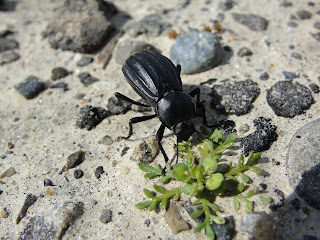Perhaps more appropriately though, I found this individual within a block or two of where the first Thanksgiving was celebrated near Williamsberg, Virginia. I was visiting my son Spencer, who is working on his doctorate in Colonial History at William and Mary, and as I was driving towards town I stopped to have a look in some old fallen timber. This is where I found the beetle and this historical marker.
It surprised me that the first Thanksgiving was celebrated in Virginia and not in New England - and in 1619, not later with the Pilgrims. Since I'm not a historian, I'll leave it others to explain my (and probably others') confusion on this. I should also mention, that mid-November is not a good time to be walking around the forests near Williamsburg. I was stopped by a gentleman dressed in hunting gear and notified that it wasn't safe to be about. In fact I was looking for beetles on the opening day of muzzle-loader season. Here's a picture of scenic Lake Matoaka near campus, and the habitat typical of P. virescens.









